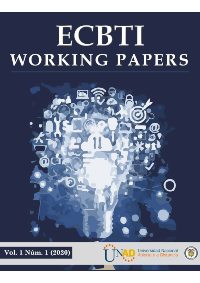Copyright (c) 2021 Documentos de Trabajo ECBTI

This work is licensed under a Creative Commons Attribution-NonCommercial-ShareAlike 4.0 International License.
The operative treatment of logistics flow in manufacturing: a pending issue in bowersox´s pipeline theory?
Everything there is to talk about logistics and logistics flows has been said in the last 100 years. However, when researching the literature, looking for foundational elements of the structure that describes the passage of the logistics flow through the system and its components, although the "columns" and "foundations" of this construction are found, it can be seen from the logistics work a treatment of planning and control rather than physical management of the flow of materials, goods, services and operational information that is transparent in the processes of supply and distribution but that in production is assumed by this department. Assuming a systematic review of a historical-conceptual type, we seek to understand if this gap exists and the reasons why it is maintained, if it exists. If this is so, it becomes the starting point for studies that contribute to the solution of this apparent discontinuity and thus, give formal operational treatment to the Pipeline concept proposed by Bowersox.
American Society of Mechanical Engineers. (1947). Operation and Flow Process Chart. ASME, Special committee on standardization of therbligs, process chats and their symbols. New York: ASME. Recuperado el 25 de 07 de 2020, de https://babel.hathitrust.org/cgi/pt?id=mdp.39015039876274&view=1up&seq=4
Antún, J. P. (1993). Logística, una visión Sistemica. Mexico D.F.: Instituto Mexicano de Transporte. Recuperado de https://www.imt.mx/archivos/Publicaciones/DocumentoTecnico/dt14.pdf
Ballou, R. H. (2004). Logística. Administración de la cadena de Suministro (Quinta ed.). Mexico D.F.: Pearson. Recuperado el 12 de Junio de 2019
Ballou, R. H. (2006). The evolution and future of logistics and supply chain management. Produção, 16(3), 375-386. Recuperado el 8 de Junio de 2019, de http://www.scielo.br/scielo.php?script=sci_arttext&pid=S0103-65132006000300002
Blancou, J. (2001). A history of the traceability of animals and animal products. Revue Scientifique Et Technique, 413-25.
Borsodi, R. (1927). The Distribution Age, a study of the economy of moderm distribution. New York: D. Appleton and Company. Recuperado el 9 de Junio de 2019, de https://soilandhealth.org/wp-content/uploads/0303critic/030308borsodi.dist.age/030308toc.htm
Bosona, T., & Gebresenbet, G. (2013). Food traceability as an integral part of logistics management in food. Food Control, 32-48. Recuperado el 02 de 05 de 2020, de http://www.ssu.ac.ir/cms/fileadmin/user_upload/Daneshkadaha/dbehdasht/behdasht_imani/article/Food-traceability-as-an-integral-part-of-logistics-management-in-food-and-agricultural-supply-chain_2013_Food-Control.pdf
Bowersox, D. (1978). Logistical Management. New York: MacMillan Publishing Co.
Bowersox, D. (1978). The Logistics of the Last Quarter of The 20th Century. Journa of Bussiness Logistics, 1(1), 1-17. Recuperado de http://search.ebscohost.com.bibliotecavirtual.unad.edu.co/login.aspx?direct=true&db=buh&AN=6962283&lang=es&site=eds-live&scope=site.
Bowersox, D. J. (Enero de 1969). Physical Distribution Development, Current Status, and potential. Journal of Marketing, 63-70. Recuperado el 8 de Junio de 2019, de https://link.springer.com/chapter/10.1007/978-1-4613-4379-0_19
Bowersox, D. J., Closs, D. J., & Cooper, B. (2007). Administración y logística en la cadena de suministros (Segunda ed.). Mexico D.F.: McGRAW-HILL/INTERAMERICANA EDITORES, S.A.
Brewer, S. H. (1 de Enero de 1960). Rhochrematics ; a scientific approach to the management of material flows. Seattle: Bureau of Business Research, College of Business Administration, University of Washington. Recuperado el 21 de 09 de 2019
Brewer, S., & Rosenzweig, J. (1961). Rhochrematics and Organizational Adjustments. California Management Review, 3(3), 52-71. Recuperado de https://bd.usergioarboleda.edu.co:2289/10.2307/41165453
Carrasco, J. (2000). Evolución de los enfoques y conceptos de la Logística. su impacto en la dirección y gestión de las organizaciones. Economía Industrial, 17-34. Recuperado el 8 de 8 de 2020, de https://www.mincotur.gob.es/Publicaciones/Publicacionesperiodicas/EconomiaIndustrial/RevistaEconomiaIndustrial/331/06.JAVIER%20CARRASCO.pdf
Cheng, M., & Simmons, J. (1994). Traceability in manufacturing systems. International Journal of Operations & Production Management, 4-16.
Chiavenato, I. (2007). Introducción a la teoria general de la administración (Séptima ed.). Mexico D.F., Mexico: Mc Graw Hill Ineramericana.
Clark, F. E. (1922). Principles of marketing (Primera ed.). Chicago: The Macmillan Company. Recuperado de https://archive.org/details/principlesofmark00clarrich/page/n5
Comitte of Operations Research. (1951). Operations Research with special reference to Non Militar Aplications. Washington: National Research Council. Recuperado el 10 de 6 de 2020, de https://babel.hathitrust.org/cgi/pt?id=uc1.b4233448&view=1up&seq=5
Coyle, J., Langley, C. J., Gibson, B., Novack, R. A., & Bardi, E. J. (2009). Supply Chain Management: A Logistics Perspective. Mason: South-Western Cengage Learning. Recuperado el 25 de 7 de 2020
David, D., Oussama, B., Ammar, E., & LeporiMarc, B. (2013). Analysis method of the relations between MRP parameter and performance indicator based on a literature review. IFAC Proceedings Volumes, 46 -9, págs. 377-382. Saint Petersburg, Russia. Recuperado el 18 de 8 de 2020, de http://www.sciencedirect.com/science/article/pii/S1474667016343142
De Hayes Jr., D. W., & Taylor, R. l. (Junio de 1972). Making “Logistics” Work in a Firm. Business Horizons, 15(3), 37-46. Recuperado de http://search.ebscohost.com.bibliotecavirtual.unad.edu.co/login.aspx?direct=true&db=buh&AN=4523169&lang=es&site=eds-live&scope=site.
Delgado, J., & Marín, F. (2000). Evolución en los sistemas de gestión empresarial. Del MRP al ERP. Economia Industrial, 51-58. Recuperado de https://www.mincotur.gob.es/Publicaciones/Publicacionesperiodicas/EconomiaIndustrial/RevistaEconomiaIndustrial/331/09.JOAQUIN%20DELGADO.pdf
Dowlatshahi, S. (2000). Developing a Theory of Reverse Logistics. Interfaces, 30(3), 143–155. Recuperado de https://doi-org.bibliotecavirtual.unad.edu.co/10.1287/inte.30.3.143.11670
Fleischmann, M., Bloemhof-Ruwaard, J. M., Dekker, R., Van Der Laan, E., Van Nunen , J., & Van Nunen, L. (1997). Quantitative models for reverse logistics: A review. European Journal of Operations Research, 103, 1-17.
Forrester, J. W. (1961). Industrial Dynamics. Boston, USA: M.I.T. Press. Recuperado de http://www.laprospective.fr/dyn/francais/memoire/autres_textes_de_la_prospective/autres_ouvrages_numerises/industrial-dynamics-forrester-1961.pdf
Ghiani, G., Laporte, G., & Musmanno, R. (2013). Introduction to Logistics Systems Management. Chichester: John Wiley and Sons.
Gill, P. E., Murray, W., Saunders, M. A., Tomlin, J. A., & Wright, M. H. (2008). George B. Dantzig and systems optimization. Discrete Optmization, 151-158. Recuperado de https://www.sciencedirect.com/science/article/pii/S1572528607000321#b6
Goldsby, T. J., Zinn, W., Closs, D. J., Daugherty, P. J., Stock, J. R., Fawcett, S. E., & Waller, M. (2019). Reflections on 40 Years of the Journal of Business Logistics: From the Editors. Journal of Business Logistics, 40(1), 4-29. Recuperado de https://doi.org/10.1111/jbl.12208
Guirong, Z., & Yixin, M. (2010). Green Logistics Management of Logistics Enterprises. 2010 3rd International Conference on Information Management, Innovation Management and Industrial Engineering (págs. 567-569). Jinan China: IEEE. Recuperado el 16 de 08 de 2020, de https://ieeexplore-ieee-org.bibliotecavirtual.unad.edu.co/stamp/stamp.jsp?tp=&arnumber=5694641&tag=1
Haykal Ammar, M., Benaissa, M., & Chabchoub, H. (2015). Traceability Management System: Literature review an Proposal of a system integrating Risk Management for Hazardous Management Products transportation. IEEE ICALT, 229-34.
Herrera, M., & Orjuela, J. (2014). Perspectiva de trazabilidad en la cadena de suministros de frutas:un enfoque desde la dinamica de sistemas. Ingeniería, 19(2), 63-84.
Heskett, J. (1966). A Missing Link in Physical Distribution Design. Journal of Marketing, 37-41. Recuperado de https://doi.org/10.1177/002224296603000408
Heskett, J. L. (1977). Logistics - essential to Strategy. Harvard Business Review Home, 11. Recuperado de https://hbr.org/1977/11/logistics-essential-to-strategy
Hou, H., Chaudhry, S., Chen, Y., & Hu, M. (2017). Physical distribution, logistics, supply chain management, and the material flow theory: a historical perspective. Inf Technol Manag, 18, 107-117. Recuperado el 23 de 07 de 2020, de https://link.springer.com/article/10.1007/s10799-015-0229-1
Imai, M. (2012). Gemba Kaizen A Commonsense Approach to a Continuous Improvement Strategy (2 ed.). New York: Mc Graw Hill. Recuperado el 13 de 12 de 2019
Industrial College of the Armed Forces Study. (1997). The Big 'L' : American logistics in World War II. (A. Gropman, Ed.) Washignton D.C.: National Defence University Defence. Recuperado el 5 de 12 de 2019, de https://babel.hathitrust.org/cgi/pt?id=uc1.31210011018254&view=1up&seq=5
Informs.org. (1 de 1 de 2020). Informs.org. Recuperado el 18 de 3 de 2020, de George B. Dantzig: https://www.informs.org/Explore/History-of-O.R.-Excellence/Biographical-Profiles/Dantzig-George-B
Kent Jr., J., & Flint, D. J. (1997). Perspectives on the evolution of the Logitics thought. Journal of Business Logistics, 18(2), 15-29. Recuperado el 12 de 09 de 2019, de http://search.ebscohost.com.bibliotecavirtual.unad.edu.co/login.aspx?direct=true&db=buh&AN=1443454&lang=es&site=eds-live&scope=site
Laseter, T., & Oliver, K. (2003). When Will Supply Chain Management Grow Up? Recuperado el 1 de Junio de 2019, de Strategy+Bussiness: https://www.strategy-business.com/article/03304?pg=0
Lummus, R., & Vokurka, R. (1999). Defining supply chain management: A historical perspective and practical guidelines. Industrial Management & Data Systems, 99(1), 11-17. doi: http://dx.doi.org.bibliotecavirtual.unad.edu.co/10.1108/02635579910243851
Malindžák, D., Olejarz, T., & Gazda, A. (Abril-Junio de 2018). Logistics, science of present day and future. Moderm Management Review, 37-49. Recuperado el 10 de 8 de 2020, de http://doi.prz.edu.pl/pl/pdf/zim/334
MHI. (1951). Modern methods of materials handling. New York: Prentice Hall Inc. Recuperado de https://babel.hathitrust.org/cgi/pt?id=mdp.39015006076981&view=1up&seq=7
MHI. (2015). MHI History, 70 years. Recuperado el 3 de 08 de 2020, de MHi.org: https://www.mhi.org/downloads/about/MHI_History.pdf
Montreuil, B. (2011). Toward a Physical Internet Meeting the Global Logistics Sustainability Grand Challenge. En Cirrelt (Ed.), https://www.cirrelt.ca/documentstravail/cirrelt-2011-03.pdf (págs. 71-87). Quebec: Cirrelt. Recuperado el 10 de 12 de 2016, de https://www.cirrelt.ca/documentstravail/cirrelt-2011-03.pdf
Orlicky, J. A. (1975). Material Requirements Planning, The new way of life in production and inventory Management. New York: McGraw-Hill, NY, 1975.
Pau i Cos, J., & De Navascues y Gasea, R. (2001). Manual de Logística Integral. Madrid: Diaz de Santos. Recuperado el 3 de 9 de 2020, de https://elibro-net.bibliotecavirtual.unad.edu.co/es/ereader/unad/52943?page=13
Pinheiro de Lima, O., Breval Santiago, S., Rodríguez Taboada, C., & Follmann, N. (2017). Una nueva definición de la logística interna y forma de evaluar la misma. Ingeniare. Revista chilena de ingeniería, 25(2), 264-276. Recuperado el 17 de 04 de 2020, de https://dx.doi.org/10.4067/S0718-33052017000200264
Porter, M. E. (1985). Competitive Advantage Creating and Sustaining Superior Performance. New York: Free Press. Recuperado de https://es.scribd.com/document/156634860/Competitive-Advantage-Creating-and-Sustaining-Superior-Performance-Michael-Porter-1985
Porter, M. E. (1991). Ventaja Competitiva, Creación y sostenimiento de un desempeño superior. (M. A. Sevlla, Trad.) Buenos Aires, Argentina: Compañia Editorial Continental S.A. de C.V. Recuperado el 12 de 05 de 2020
Rincón Ballesteros, D. L. (2016). http://repository.udistrital.edu.co. Recuperado el 22 de Mayo de 2018, de Repositorio UNiversidad Distrital Francisco Jose de Caldas: http://repository.udistrital.edu.co/bitstream/11349/2811/1/RinconBallesterosDoraLucia2016.PDF
RLSC. (29 de 3 de 2016). reverselogistics.com. Recuperado el 16 de 8 de 2020, de http://www.reverselogistics.com/RLSC/files/1114/5922/5940/RLSC_Fact_Sheet_3-29-16.pdf
Sarraj, R., Ballot, E., Pan, S., & Montreuil, B. (30 de 9 de 2012). Analogies between Internet network and logistics service. Springer. Springer, 1209-1219. Recuperado el 8 de 10 de 2015, de https://doi.org/10.1007/s10845-012-0697-7
Seroka-Stolka, O. (2014). The Development of Green Logistics for Implementation Sustainable Development Strategy in Companies. Procedia - Social and Behavioral Sciences, 302-309. Recuperado de https://doi.org/10.1016/j.sbspro.2014.10.028
Servera-Francés, D. (Septiembre-Diciembre de 2010). Concepto y evolución de la función Logística. Innovar Journal, 20(38), 217-234. Recuperado el 10 de Junio de 2019, de http://www.redalyc.org/articulo.oa?id=81819024018
Shaw, A. W. (1916). Some problems in Market Distribution. Boston: Harvard University Press. Recuperado el 11 de Junio de 2019, de https://babel.hathitrust.org/cgi/pt?id=mdp.39015063904661&view=1up&seq=4
Smykay, E., Bowersox, D., & Mossman, F. (1961). Physical distribution management; logistics problems of Firm. New York: The Macmillan Company. Recuperado el 19 de 07 de 2020, de https://babel.hathitrust.org/cgi/pt?id=uc1.$b100077&view=1up&seq=7
Stock, J. (1992). Reverse Logistics. . Oakbrook IL: Council of Logistics Management.
Taniguchi, E., & Van Der Heijden, r. (2000). An evaluation methodology for city logistics. Transport Reviews.
The Ohio State University. (1 de 1 de 2020). fisher.osu.edu. Recuperado de Douglas M. Lambert: https://fisher.osu.edu/people/lambert.119
Trautman, D., Goddard, E., & Nilsson, T. (2008). Traceability, a literature Review. University of Alberta, Deparment of Rural Economy. Edmonton: University of Alberta.
Von Bertalanffy, L. (1989). Teoria General de Sistemas, fundamentos, desarrollo, aplicaciones. Ciudad de Mexico: Fondo de Cultura Económica.
Wilson, J. (2016). The origin of Materials Requirements Planning in Frederick W. Taylor's planning office. International Journal of Production Research, 54(5), 1535-1553. Recuperado de http://eprints.gla.ac.uk/112204/
Copyright (c) 2021 Documentos de Trabajo ECBTI

This work is licensed under a Creative Commons Attribution-NonCommercial-ShareAlike 4.0 International License.





